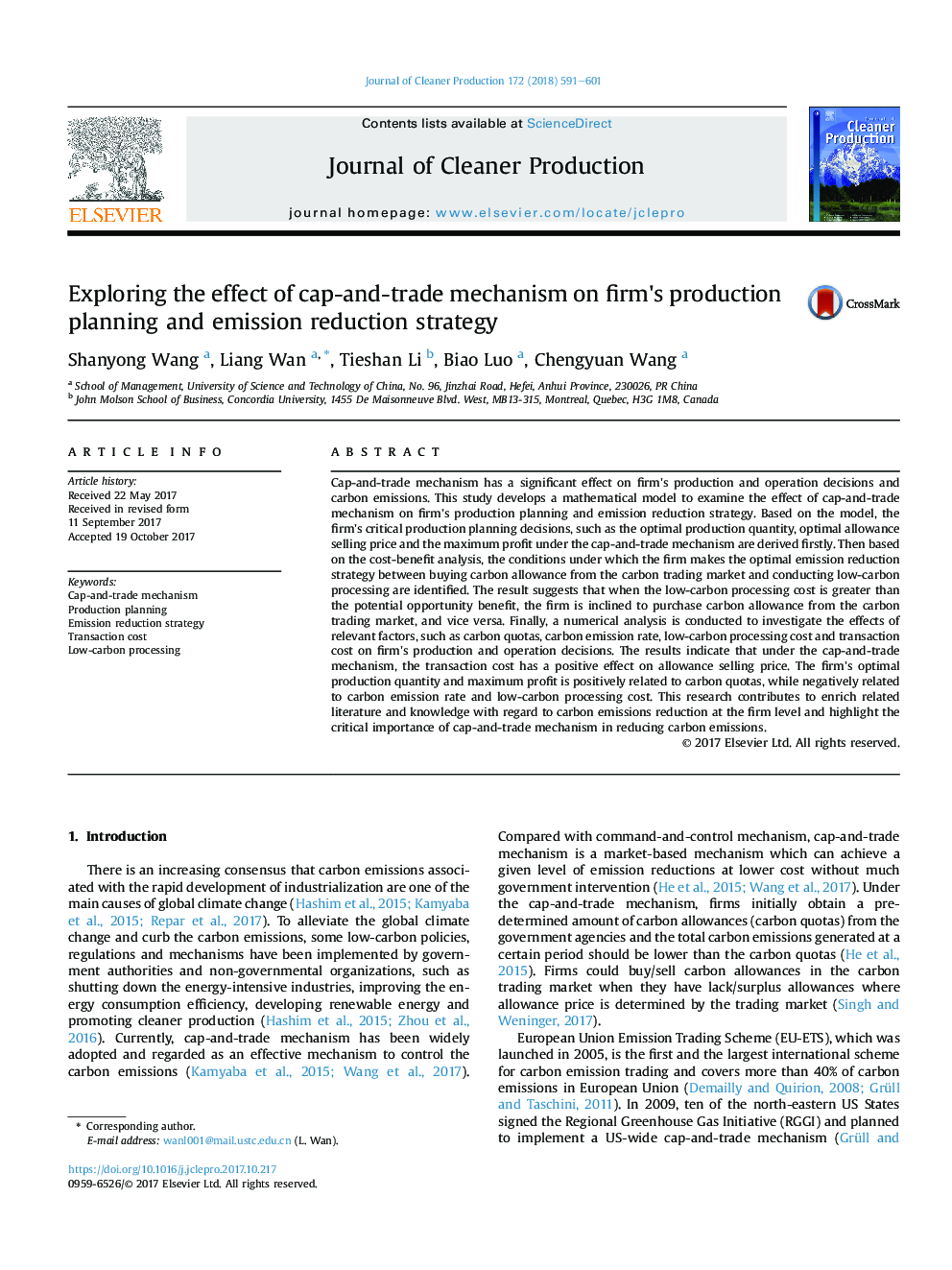| کد مقاله | کد نشریه | سال انتشار | مقاله انگلیسی | نسخه تمام متن |
|---|---|---|---|---|
| 8099958 | 1522081 | 2018 | 11 صفحه PDF | دانلود رایگان |
عنوان انگلیسی مقاله ISI
Exploring the effect of cap-and-trade mechanism on firm's production planning and emission reduction strategy
ترجمه فارسی عنوان
بررسی تاثیر مکانیسم چرخه و تجارت در برنامه ریزی تولید شرکت و کاهش استراتژی کاهش انتشار
دانلود مقاله + سفارش ترجمه
دانلود مقاله ISI انگلیسی
رایگان برای ایرانیان
کلمات کلیدی
مکانیسم چابک و تجارت، طرح تولید، استراتژی کاهش میزان انتشار، هزینه تراکنش، پردازش کم کربن،
ترجمه چکیده
مکانیسم سرپوش و تجارت تأثیر قابل توجهی بر تصمیمات تولید و عملیات شرکت و انتشار کربن دارد. این مطالعه یک مدل ریاضی برای بررسی تأثیر مکانیسم کلاهبرداری و تجارت در برنامه ریزی تولید شرکت و کاهش استراتژی انتشار را توسعه می دهد. بر اساس مدل، تصمیم گیری های مهم در مورد تصمیم گیری های تولیدی شرکت مانند میزان تولید مطلوب، قیمت فروش مطلوب و حداکثر سود تحت مکانیسم کلاهبرداری و تجارت، در ابتدا صورت می گیرد. سپس براساس تجزیه و تحلیل هزینه-سود، بر اساس شرایطی که شرکت راهبرد بهینه سازی کاهش هزینه را از خرید کربن از بازار تجارت کربن و انجام پردازش کم کربن شناسایی می کند، مشخص می شود. نتیجه نشان می دهد که وقتی هزینه پردازش کم کربن بیشتر از مزیت فرصت بالقوه باشد، شرکت تمایل دارد که از خرید کالای کربن از بازار کالای کربن خریداری کند و بالعکس. در نهایت، تجزیه و تحلیل عددی برای بررسی اثرات عوامل مرتبط، مانند کربن، نرخ انتشار کربن، هزینه پردازش کم کربن و هزینه معامله در تصمیمات تولید و عملیات شرکت انجام می شود. نتایج نشان می دهد که تحت مکانیزم کلاه و تجارت، هزینه معامله تاثیر مثبتی بر قیمت فروش مجوز دارد. کمترین مقدار تولید و حداکثر سود شرکت به طور مثبت با کربن کربن مرتبط است، در حالی که منفی به میزان انتشار کربن و هزینه پردازش کم کربن مربوط است. این تحقیق موجب غنی سازی ادبیات و دانش مرتبط با کاهش انتشار کربن در سطح شرکت می شود و اهمیت حیاتی مکانیسم کلاه و تجارت در کاهش انتشار کربن را نشان می دهد.
موضوعات مرتبط
مهندسی و علوم پایه
مهندسی انرژی
انرژی های تجدید پذیر، توسعه پایدار و محیط زیست
چکیده انگلیسی
Cap-and-trade mechanism has a significant effect on firm's production and operation decisions and carbon emissions. This study develops a mathematical model to examine the effect of cap-and-trade mechanism on firm's production planning and emission reduction strategy. Based on the model, the firm's critical production planning decisions, such as the optimal production quantity, optimal allowance selling price and the maximum profit under the cap-and-trade mechanism are derived firstly. Then based on the cost-benefit analysis, the conditions under which the firm makes the optimal emission reduction strategy between buying carbon allowance from the carbon trading market and conducting low-carbon processing are identified. The result suggests that when the low-carbon processing cost is greater than the potential opportunity benefit, the firm is inclined to purchase carbon allowance from the carbon trading market, and vice versa. Finally, a numerical analysis is conducted to investigate the effects of relevant factors, such as carbon quotas, carbon emission rate, low-carbon processing cost and transaction cost on firm's production and operation decisions. The results indicate that under the cap-and-trade mechanism, the transaction cost has a positive effect on allowance selling price. The firm's optimal production quantity and maximum profit is positively related to carbon quotas, while negatively related to carbon emission rate and low-carbon processing cost. This research contributes to enrich related literature and knowledge with regard to carbon emissions reduction at the firm level and highlight the critical importance of cap-and-trade mechanism in reducing carbon emissions.
ناشر
Database: Elsevier - ScienceDirect (ساینس دایرکت)
Journal: Journal of Cleaner Production - Volume 172, 20 January 2018, Pages 591-601
Journal: Journal of Cleaner Production - Volume 172, 20 January 2018, Pages 591-601
نویسندگان
Shanyong Wang, Liang Wan, Tieshan Li, Biao Luo, Chengyuan Wang,
